Case Study: From 0 to 20K Organic Users in 10 Months
Want help with your SEO? We have 5+ years of experience driving high-intent traffic and creating content that converts.
Get a free audit to see how much potential your website has.
While many companies rely heavily on paid ads, organic traffic remains the ultimate achievement in marketing.
What if your business could drive traffic without paying for every click? No more ads running? Sales stop. That’s the reality for ad-dependent companies.
But what if your traffic and leads were sustained by organic reach alone? That’s where Search Engine Optimization (SEO) steps in. SEO builds a consistent flow of visitors to your site, with no ongoing ad costs. Although it doesn’t yield instant results, the long-term impact of investing in SEO is unmatched.
In this case study, we’ll share how we scaled JCS Refresh—a pressure washing and exterior cleaning company—from 0 to 20,000 organic visitors in just ten months.
JCS Refresh’s traffic strategy was built on:
- A robust content strategy alone
- A brand-new domain
- Minimal link-building efforts
Let’s break down our process.
Phase 1 – Crafting a Content Strategy
A solid plan is where it all begins.
The Hub and Spoke Strategy
Keyword research is critical in SEO, and for JCS Refresh, we relied on the tried-and-true “hub and spoke” content model.
Picture a museum layout for a clear analogy: the main exhibit room (the hub) covers the central theme, while the side rooms (spokes) showcase detailed pieces tied to that theme. In JCS Refresh’s case, the “hub” content focused on pressure washing basics, while each “spoke” delved into specific services, cleaning tips, and benefits. This interconnected content structure builds authority, relevance, and improves search visibility within their industry.
Phase 1 – Developing a Content Strategy
Like many things, having a confident plan makes all the difference.
The Hub and Spoke Strategy
In SEO, keyword research is the cornerstone of success. We used the hub and spoke content model for JCS Refresh, sometimes called the ‘hubbing strategy.’
To better understand the hub and spoke strategy, imagine a bike (this is your website); the wheels are content categories. Your ‘hub’ article covers one main topic, while the ‘spoke’ article covers subtopics—all link together, increasing authority and relevance within a niche or industry.
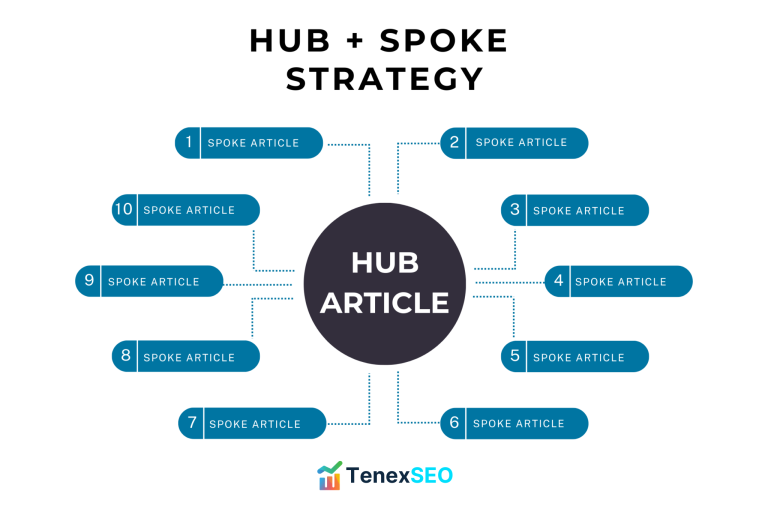
In the pressure washing and exterior cleaning space, there are a few primary categories:
- Pressure Washing
- Soft Washing
- Moss Removal
- Gutter Cleaning
- Spray Paint Removal
These categories represent services and topics people are likely to search for when looking to learn more about pressure washing.
Building Authority
To build authority, it’s essential to thoroughly cover each of these categories with high-quality content.
This signals to search engines like Google, “I’m a subject matter expert with valuable content for visitors in this area. Rank my pages so they’re easy for people to find.”
Effective keyword research and content planning is a refined process—while anyone can access similar tools, the outcome depends on how you choose to apply them.
When conducting keyword research, it’s essential to explore each main category and identify relevant subtopics. These subtopics become spokes within our strategy.
For instance, under the main category of pressure washing, relevant subtopics might include:
- Houses
- Fences
- Decks
- Concrete
- Driveways
- Accessories
Each of these subtopics holds the potential for multiple blog ideas. For example, someone researching “how to pressure wash a house” may also be interested in topics like “what pressure washing does to shingles.”
Content Planning
Our roadmap takes shape as we go down the rabbit hole and continue our keyword research.
In the picture below, you’ll notice that our ‘hub’ article is “how to pressure wash a house,” and the ‘spoke’ topics relate to pressure washing a house. Even within spoke categories are mini groups, such as ‘brick.’
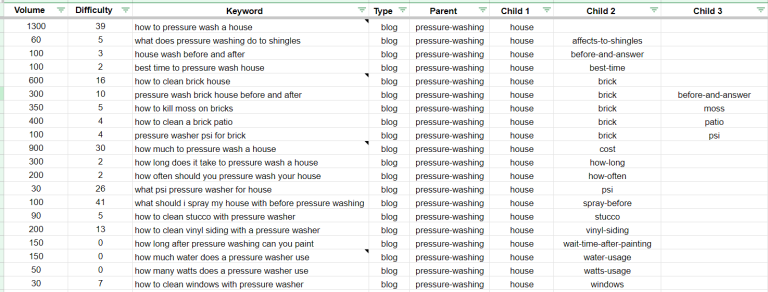
Moreover, we can see volume (the number of average monthly searches in the US) and keyword difficulty (how hard it is to rank on the first page of Google).
Below is another example within the “how to use a pressure washer” hub.
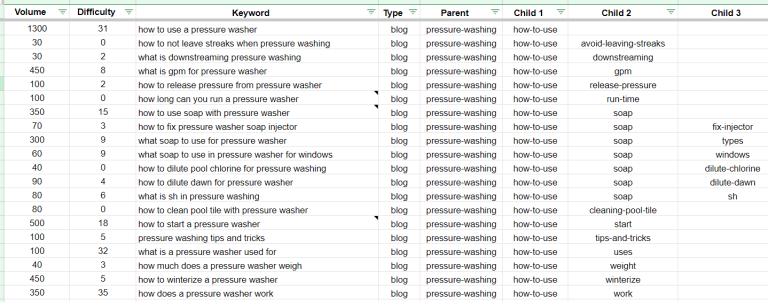
Key Takeaways
Once our keyword research is done, we can quickly get a 30,000-foot view of the following:
- The number of content hubs
- The number of topics within a hub
- The difficulty of ranking our topics amongst competitors
- How many people are searching for phrases per month
Using this information, we can:
- Forecast the blog’s content budget
- Forecast the project completion date
- Know how many writers we need to hire
- Start planning writer briefs and outlines
It’s worth noting that the hub and spoke content strategy works best when blogs are written (and published) in order of importance. Importance, in this case, can mean competition or relevancy.
For example, with JCS Refresh, the company’s core offering is pressure washing, so it wouldn’t make sense to write ‘gutter cleaning’ content first. Instead, we segmented the pressure washing hub by topic relevance and competition, then set out to write each subcategory, start to finish, in order.
Phase 2 – Writing Content
While planning and researching keywords is essential, there’s nothing like watching a strategy turn into real, published content.
With our roadmap ready, we started developing writer briefs and outlines. For this project, we chose a “sprint strategy,” aiming to produce content quickly. We hired five writers for JCS Refresh, with a target of 20-30 articles each month, depending on length.
Creating this volume of content meant producing numerous outlines, so we got to work.
Each article outline (or brief) is crucial to the SEO strategy, guiding writers to produce content that’s well-targeted, optimized, and informative. We focus on key elements like:
- User experience (UX)
- Primary keyword
- Secondary keywords
- Article length
- Competitor analysis
- Topic relevance
- SEO Tools
To streamline our process, we rely on Ahrefs, an SEO tool that helps our team analyze competitor content and identify ranking keywords. With this data, combined with our own research, we start designing detailed briefs.
We also incorporate SEOwind, an AI-powered tool that optimizes keywords, headings, and keyword clusters for content briefs.
Investing time to research competitors and conduct secondary keyword analysis is key. Many rush to publish and wonder why their articles don’t perform well. Our approach is different: since content (and SEO) takes time to yield results, setting up briefs strategically is well worth the upfront effort.
SEO is a game of patience—lay the groundwork early, and future performance will reflect it.
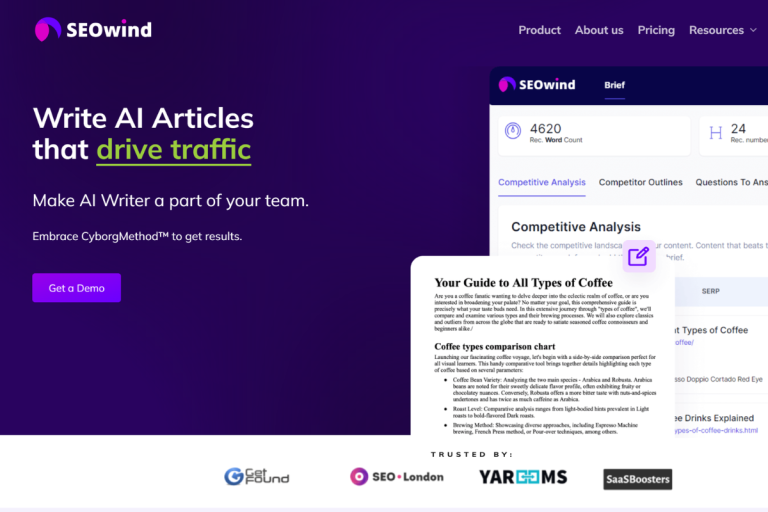
Working With Writers
When we work with writers, it’s essential to communicate the vision behind each piece and how it aligns with our broader content strategy. We provide comprehensive content briefs detailing brand tone, messaging, and target reading level.
While it’s crucial for content to be optimized for search engines, it must primarily appeal to readers. Many in SEO make the mistake of focusing solely on algorithms, neglecting the human audience.
Once a writer submits a draft, we review it thoroughly to ensure it meets our quality standards.
Key questions we consider during this process:
- Did the writer follow the brief closely?
- Is the content concise and free from filler?
- Are images, if used, properly licensed?
- Are sections answered clearly and completely?
- Has the writer included relevant links to credible sources?
If any adjustments are needed, we collaborate with the writer to refine the draft into its final form.
Phase 3 – On-page SEO
The next phase is uploading articles to the site and optimizing each with on-page SEO fundamentals.
What is On-page SEO?
On-page SEO involves optimizing various elements directly on a webpage to help search engines like Google interpret and rank it effectively. The aim is to align each page with target keywords, making it easy for search engines to understand and for readers to engage.
Core Components of On-page SEO:
Title Tags: These are clickable titles in search results. We use the main keyword here and ensure it accurately reflects the page’s content.
Meta Descriptions: This short summary appears below the title tag in search results. A well-crafted meta description isn’t a direct ranking factor but can boost click-through rates and inform Google about the page.
Headings (H1-H6): Proper use of header tags organizes the content by main topics and subtopics. H1 is typically the page title, while H2-H6 tags break down subheadings to keep the structure clear.
URL Structure: Clean, concise URLs with target keywords improve user experience and help search engines understand page content.
Keyword Usage: We incorporate relevant keywords naturally throughout the content to clarify the page’s focus to search engines.
Internal Linking: This is one of our specialties. Linking to other site pages spreads “link equity” and helps users find related content, boosting engagement and making it easier for search engines to crawl and rank the site.
Content Quality: High-quality, original content that meets user needs is essential, as search engines prioritize content that aligns with user intent.
Image Optimization: We include descriptive filenames and alt text for images, helping search engines interpret their content. Optimized images also load faster, which can improve site speed, a ranking factor.
Responsive Design: Ensuring mobile-friendliness is crucial, as Google now indexes sites based on their mobile versions.
Site Speed: Faster sites improve user experience and are favored by search engines.
In summary, on-page SEO focuses on optimizing individual pages to boost search engine rankings and attract relevant traffic. By refining both the content and HTML, we set up each page for long-term success in search results.
Let Your Content E-E-A-T
E-E-A-T is one of many guidelines Google uses to determine whether content is valuable. Don’t ignore this little acronym.
Here’s what it means:
Experience
- Does content demonstrate experience?
- Did you actually travel to the place?
- Did you actually use the product?
- Did you actually do the thing?
Expertise
- Is the information correct?
- Do you know about the thing?
- What career experience proves this?
Authoritativeness
- Does your site have niche authority?
- How many backlinks do you have?
- Are they relevant to your niche?
- Are they from trusted sources?
- How about testimonials?
Trustworthiness
- This evaluates credibility + reliability
- Can people contact you quickly?
- How do you handle user data?
- Do you have a privacy policy?
- Do you have a cookie policy?
- Are URLs using HTTPS?
Although Google has officially noted that this is not a direct ranking factor, it does gauge good content from bad. And when it comes to SEO, better content = better rankings.
We considered this while building JCS Refresh’s blog.
Two ways to build E-E-A-T into this content strategy were:
1 ) Start each blog with a welcome message from the author
- Outline who they are with a short bio
- What expertise do they bring to the topic?
- Include links to social media
2) Include branded photos of the author to support content
- If possible, this is a massive win
- People are bored with generic stock photos
- Add pictures of the author to boost credibility
Combined with the list of on-page SEO strategies above, these methods make for a great combination.
However, we continued optimizing JCS Refresh and had a few more tricks up our sleeve.
Hub Pages & Site Structure
Beyond refining individual articles, we enhanced JCS Refresh’s overall SEO by establishing “hub pages” and focusing on site structure.
Hub Pages in the Hub and Spoke Model
In the hub and spoke framework, each “hub” is a core, comprehensive piece of content covering a main topic, with related “spoke” articles branching out to explore subtopics. Think of the hubs as foundational content pillars—like a page on “how to pressure wash a house”—each surrounded by spokes that delve into related subtopics, linking back to the main hub for relevance and authority.
To visualize this, we structured a spreadsheet showing hub topics and their corresponding spokes, which helped us keep internal linking consistent. Each spoke linked back to the hub, creating a strong internal link network, boosting SEO, and improving user experience.
Streamlined Navigation with Hub and Explore Pages
We also designed dedicated “hub” pages to group related content together, making it easier for visitors to navigate. For instance, we created a Deck Cleaning hub page, centralizing all content related to deck cleaning. This page was then linked within the navigation menu and footer, giving it a prominent, accessible placement on the site.
We also developed an Explore page, acting as a comprehensive site map. This front-facing page categorized all content and linked directly to every URL on the site, neatly organized for easy navigation. Placing the Explore page, along with other hub pages, in the site’s navigation and footer meant they were always accessible to both visitors and search engines, ensuring optimal site crawlability and enhanced user experience.
This layered, structured approach helped make JCS Refresh’s site more organized and search-friendly, while also improving accessibility and user engagement.
Phase 4 – Off-page SEO
In addition to on-page SEO and all of the “magic” behind the scenes, off-page SEO is an integral part of any strategy.
However, we did very little off-page optimizations for JCS Refresh and still saw incredible growth.
What’s Off-page SEO?
Off-page SEO involves actions taken outside of your website to enhance its authority and ranking potential. This is about building a reputation and trust within your industry. Key components include:
- Backlinks: Attracting links from reputable sites; quality, relevance, and authority of backlinks strongly impact ranking.
- Social Signals: Engagement across social media platforms, including shares, likes, and mentions.
- Guest Blogging: Publishing on other sites to gain backlinks and increase visibility.
- Local SEO: Managing listings in directories and responding to reviews.
Ultimately, off-page SEO helps search engines determine how others perceive your website, further reinforcing its relevance and authority.
Our Off-page Approach for JCS Refresh
With our content-driven approach, we didn’t dedicate much time to building backlinks. Since JCS Refresh operates as a local service company, we focused on PR articles and directory listings:
PR Articles: We published about five local PR pieces to boost awareness. While these helped with local visibility, Google often values links from high-authority global sources more than smaller news outlets.
Local Directories: We set up profiles in approximately 50 free local directories. Directory listings are especially valuable for local SEO and increase visibility in regional searches.
Google Business Profile (GBP): Optimizing the Google Business Profile (formerly Google My Business) was essential. We leveraged the Post feature in GBP, which allowed us to share regular updates and distribute blog content to enhance local engagement.
Our GBP posting process included:
- Publishing a blog on the site
- Writing a 200–300-word summary of the blog
- Creating an SEO-optimized cover image
- Adding a link to the blog
- Posting 3–5 times per week on GBP
Using GBP posts for blog distribution was a strategic choice, helping us use Google’s tools to our advantage and providing additional internal links for indexing.
- Social Media: We briefly maintained activity on Facebook and Instagram, sharing content for a few months. However, we shifted our focus back to SEO-focused site optimization, which ultimately drove greater results.
Through these selective off-page efforts, we reinforced JCS Refresh’s local SEO presence, driving authority and visibility without extensive link-building campaigns.
Phase 5 – The Results & Data
Growing organic traffic on a new domain is one of the most challenging tasks in SEO. Not only does it take a lot of content to get the ball rolling, but it also requires patience.
For example, in many cases, a new website won’t get traffic for six months after the first blog is published (best-case scenario).
Why? Because of the Google Sandbox.
The “Google Sandbox” is an informal term used by SEO professionals to describe a theory or observation that newly registered domains and websites may experience suppressed rankings in Google search results for a specific time.
JCS Refresh Growth
After launching JCS Refresh, generating decent traffic took several months.
The image below shows the total number of users from October 1st, 2022, to July 1st, 2023.
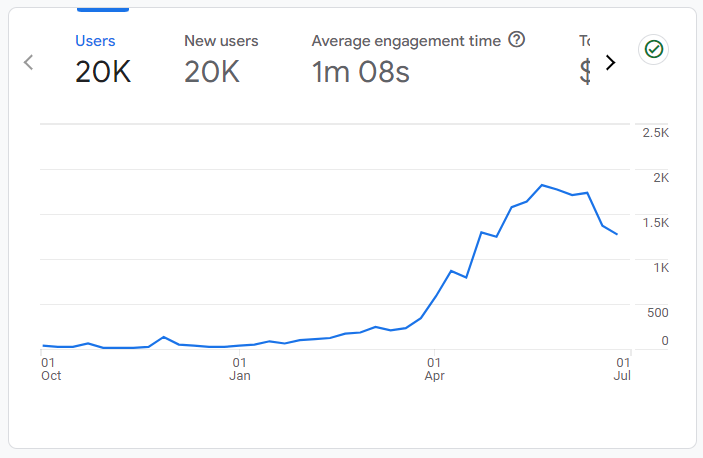
Then, in May 2023, JCS had its largest month, with 7,100 organic visitors.
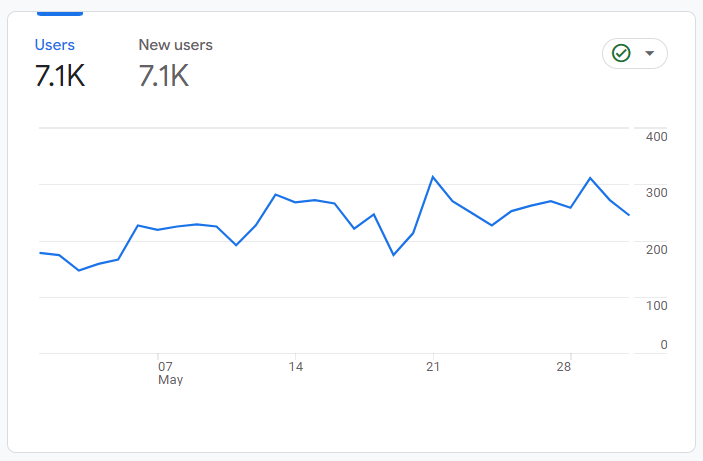
When we cross-analyzed Google Analytics data with data from Google Search Console, we saw that click and impressions data was consistent with organic visitors.
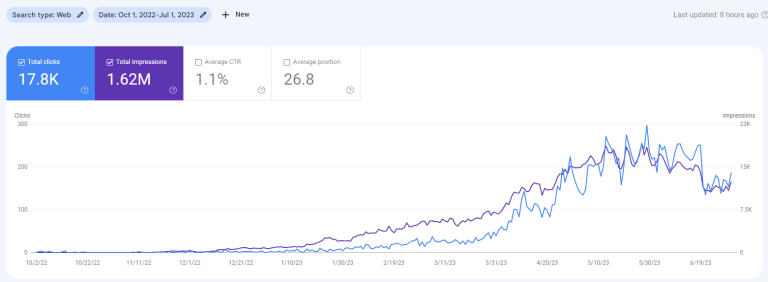
As shown in the image above, JCS Refresh generated 1,620,000 impressions in 10 months and 17,800 clicks — an incredible success for a new site with almost no backlink profile.
Taking this one step further, we consistently monitored keyword rankings in Ahrefs. We saw that JCS Refresh was securing most of the top 10 and top 3 keyword positions we targeted.

Moreover, the graph below shows how quickly we were able to index content in Google (yellow line) and how long the average organic traffic took to register (orange line).
This data is an excellent example of the Google Sandbox — content was submitted to Google months in advance, and it took nearly seven months for traffic to peak in May.
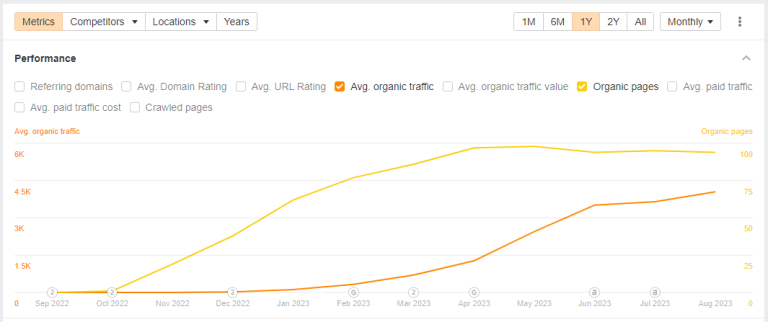
It’s worth noting that the average traffic numbers shown by Ahrefs are lower than what is displayed on Google Analytics because Ahrefs uses estimations, whereas Google has direct data.
We use several tools to map various metrics against each other and ensure no anomalies exist in the data.
Wrapping Things Up
Since the pressure washing and exterior cleaning niche is highly seasonal, we expect rankings to decline in the fall and winter and pick back up in early spring and summer.
That being said, we are thrilled to see how well JCS Refresh has performed thus far.
This case study shows the power of TenexSEO:
- Solid Strategy
- Strong Writers
- Smart Software
Want help growing organic traffic for your website?
Apply to work with us, and let’s get started.
Cheers!
